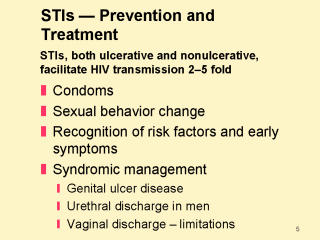| front |1 |2 |3 |4 |5 |6 |7 |8 |9 |10 |11 |12 |13 |14 |15 |16 |17 |18 |19 |20 |21 |22 |review |
 |
Because
sexually transmitted infections and HIV are so closely related, preventing STIs is an
important intervention to provent HIV infection. There are a number of ways that STDs and
HIV are closely linked. First, both ulcerative and nonulcerative STIs increase the risk of HIV transmission 2-5 times and genital ulcers disrupt the epithelial barrier. STIs also increase the number of cells vulnerable to HIV in the genital tract, increasing susceptibility in uninfected individuals. On the other hand, HIV-infected persons with STIs have increased genital tract HIV viral load, which increases infectiousness. Therefore, prevention and treatment of STIs is another important component of HIV prevention. Indeed, in one clinical trial in Tanzania, treating STDs decreased HIV seroconversion by 38% over 2 years. The best way to prevent STIs is to reduce sexual risk behaviors and to use condoms consistently and correctly. Both men and women should be educated about personal risk factors and early symptoms of STIs. Another way to prevent HIV is to treat STDs as early as possible. In areas where laboratory facilities are not available, treatment of STIs is based on groups of symptoms and signs that may be explained by more than one condition. Treatment is given for all of the most likely STIs causing the syndrome, based on local epidemiologic data. The syndromic approach is quite effective for management of genital ulcers and urethral discharge, but is less useful in managing women with abnormal vaginal discharge because of decreased accuracy in the diagnosis and treatment of cervicitis. |